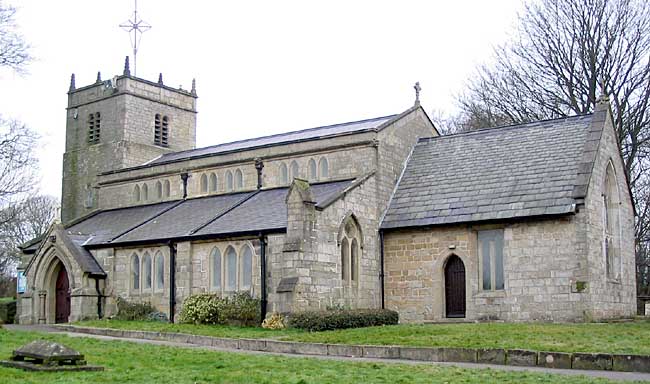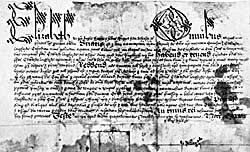Thoroton Society Summer Excursion, 1904
Skegby
ON Tuesday, the 14th June, 1904, about eighty members and friends of the Society made a delightful excursion in the Mansfield district, taking en route the churches of Skegby, Teversal, Hardwick Hall, and the churches of Mansfield Woodhouse, and Mansfield.
A start was made punctually at 9.30 a.m. from Sutton Junction, in six brakes, and though the road to Skegby was not very interesting in character, a climb up the hill, on nearing the church, revealed some charming views of the surrounding country.
On reaching the church our party was welcomed by the vicar, the Rev. H. J. Stamper, and Mr. G. G. Bonser read the following paper.

St Andrew's church, Skegby (A Nicholson, 2009).
Mr. G. G. BONSER'S PAPER.
Skegby church was anciently a chapel of Mansfield, and its dedication was long unknown. From time immemorial the village feast has been held on the first Sunday after the 10th of July. Though the church at Mansfield is dedicated to St. Peter, the ancient fair there was held on the 10th of July, and it may be that the inhabitants of Skegby held their feast at the same time.
The church was restored by the late vicar, the Rev. F. J. Taverner, in 1870, and the restoration was much needed. The north aisle was then added, and the chancel extended about nine feet. In the process of restoration, a chancel arch of Norman work, much smaller than the present one, was unfortunately destroyed; in fact nothing of the late Norman work in the church could be preserved, owing to the amount of dilapidations that in the course of years had accrued. The present ruinous condition of the church, as marked by strong timbering in the arches of the arcades and an iron band round one of the columns, is entirely due to the coal mining underneath. The walls on the outside have many ancient tombstones inserted in them; one shewing a chalice, many others swords.
There are not many points of interest left within the church; but in the south aisle there is a piscina, in situ, of the 13th century, and indicative of a chapel or chantry there in earlier days. On the same wall is the kneeling figure of a priest, which was removed from the outside of the church and was placed in its present position at the time of the church's restoration (1870). There is an inscription beneath the figure, of two lines in relief, the upper one reading "Pro anima ejus," &c., and the lower one "Paternoster."
The two most interesting stone effigies,1 now reared against the tower wall, were no doubt originally recumbent, and their excellent preservation is perhaps largely due to this change in their position. I think there cannot be the least doubt that they are of the late 13th or early 14th century. At that time the manor was held by Edmund Spigurnell, who was also seized of the manor of Staunton in Essex, and as his father was Sealer of the King's writs in A.D. 1227, and his grandfather was Sergeant of the King's Chapel about 1207, he was a man of some importance. I therefore suggest that these effigies are those of Edmund Spigurnell and his wife, A.D. 1296.

Ruins of the old Manor House, Skegby (A Nicholson, 2009).
The residence of these Spigurnells was probably near the side of the Great Northern Railway, as buildings situated near the station, and now belonging to a farm, shew undoubted traces of Transitional Norman and Early English work.2
The village of Skegby stands within the borders of Sherwood Forest, and derives its name from the "skeg" or wild plum tree, on which the peach and apricot were grafted, "by" of course being the Danish termination for "settlement."
Mr. T. M. Blagg, F.S.A., then read the following paper relating to some recently discovered inquisitions.
Mr. T. M. BLAGG'S PAPER.
Skegby, like many other places in our county, possesses so many documents of record, in the Public Record Office and elsewhere, that its history may be traced with extraordinary minuteness of detail from the days of Domesday downward. Indeed, out of the small number of Inquisitiones Post Mortem yet published by our Society, no less than five in the short space of only thirty years, 1499-1527, relate to this small parish. These all refer to the families of Lyndley and Bryde.
At least two Skegby men have attained to some distinction. Henry Spigurnel, the judge, who was called to the parliaments of 1297 and 1316, and who, in 1312, was one of the two judges who condemned Piers Gaveston; and John Bride, who was Archdeacon of Derby from 1431 to 1473. With reference to the latter man, I have here, by courtesy of Mr. Dodsley, a most interesting document, a private inquisition held at Skegby in the year 1460, interesting not only because of its somewhat unusual form and matter, but also because it tells us that the inquiry was held in the chapel of St. Andrew, of Skegby, thus fixing the patron saint of the church, the dedication of which was thought to be lost, and is stated in your programme of to-day's excursion as being unknown. The document also mentions a rood of land "lying next the cross in the eastern field" of Skegby, an incidental description which shews not only the existence of one of the then common crosses or wayside calvaries, but that it stood in the "eastern field," which would be the easternmost of the three great divisions of unenclosed arable land, when the soil of Skegby was tilled on that ancient "three-field system," which we saw still surviving when at Laxton two years ago.
Another point of interest about this inquisition is that it is dated from the pontifical instead of the regnal year; after the year of our Lord 1460 it reads, "in the third year of the eighth indiction of the pontificate of the most holy father in Christ and our Lord, the lord Pius the Second, by divine providence, Pope, on the 18th day of the month of October."
The reason of this inquisition was that Roger Bryde, having lands in Skegby, died, and these lands passed, in 1435, into the hands of his three sons, John, John, and Robert.3 On 13th February, 1460, the elder of these two Johns died at Skegby, so that his brothers, John and Robert, became sole owners of the lands. But the elder John left a young son, named after his grandfather, Roger, and this Roger accused John the younger, his uncle, of having illtreated his father, his mother, and himself, and of having caused his father's death. Now this John Bryde, junior, Roger's uncle, was Archdeacon of Derby, and was so perturbed by these accusations against himself, that he caused this inquisition to be held at Skegby in order to prove their libellous nature. In the finding of the jury, it is recorded that John Bryde was an inmate of the house of the Cistercian Order at Beauvale both before and after the death of his brother, John Bryde, senior, and that, far from having illtreated his brother's family, he had always befriended them, and had paid for the education of his nephew, Roger (who made the accusations), at a grammar school.
We have also here two early charters relating to Skegby, for permission to examine which the members are also indebted to Mr. Dodsley. The first is a charter of inspeximus of King Henry VIII. dated at Westminster 17th April, 1532, reciting a charter of the year 1500 to the effect that Thomas, son of Percival Lynley, of Skegby, had there a messuage and sixteen acres of land and a certain cleared pasture (i.e. forest land which had been redeemed and brought into cultivation), which were formerly Godfrey Spigurnell's, and that this Thomas Lynley held these lands and the manor of Skegby of the King by service, which was quitted by payment of a rent of 12d. for every service. So the said Thomas pays to the King £4. 5s. 4d. for his relief, and upon the rolls of the exchequer being examined, it was found that in the year 1309 Edward Spygurnell, son and heir of John Spygurnell, had been in like mode charged with his relief for the said manor, etc. Part of the Great Seal of England is still attached to this document.
As showing the enormous way back to which we can trace the descent of these lands from hand to hand, and the glorious continuity of our national records, I may mention that there is still in existence a charter of King John, granting to Godfrey Spigurnel "serviens noster in capella nostra" five bovates of land and a mill at Skegby in 1207.

Lease of Sutton Watermill. temp. Elizabeth.
The other charter which we have here is a grant by Queen Elizabeth on 14th November, 1596, to Edward Longford of a thirty-one years' lease of "a watermill called Sutton Mill," with the ponds of the same, within the forest of Sherwood on payment of an annual rent of 51s. 8d., etc., and giving him permission to fell timber in the forest of Sherwood "by the assignment of our officers," for the purpose of repairing the said mill, etc. Queen Elizabeth's terms of leasehold seem to have been conveniently elastic, for the document goes on to add, "provided always that if any other shall wish to give more of increase for the premises per annum, without fraud or deceit, that then the said Edward Longford, etc., are bound to pay as much, if they wish to have the custody !"
